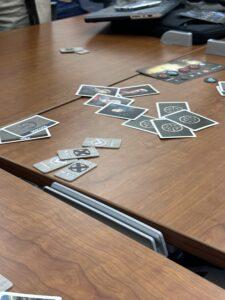The game that I played for the critical play was The Resistance, a board game created by Don Eskridge and produced by Insomniac Games. The target audience is broad as the game is suitable for any group of people (5-10 people) with a mature enough understanding to play with social deduction (likely young adults and beyond). I felt the theme and narrative of the game were not huge focal points while playing, but it may be of interest to people who are interested in dystopian-themed games.
Overall, the game was very animated and the use of social deduction was very effective in keeping the group engaged and in discussion about who the spies in the game could be. Social deduction took a huge forefront in the game as people argued over who was suspicious and who they were certain was part of the “good team.” This was due to a few different mechanics of the game which included all players having hidden identities (spies vs. the resistance), voting on a mission in a way that all players can see, allowing the spies to know each other’s identities, and forcing players to pick a subset of people to go on a mission. Because everybody’s identity was hidden from each other except for the spies, this led to the automatic dynamic of team formation and silent strategizing between spies as well as between actual resistance members who backed each other up based on an established and deduced sense of comradery. In many instances, spies supported each other’s statements and suspicions to shift blame onto other players who they knew were innocent. This team vs. team dynamic stemmed from the objective of the game which was to fool the resistance members enough (failing 3 missions for us) to win, something that could only be achieved by gaining their trust and infiltrating missions to then strategically make them fail. All of these interactions contributed to a strong sense of fellowship among spies and between players (often in pairs) as people decided who they “could trust.” In many situations, people ended up forming buddies that they argued they were certain to be on the good team. Statements often included “I trust you. I know you’re not a spy” or “I feel like you’re not lying. I trust you.” Conversely, people in these formed buddy pairs would often picky back on each other to accuse someone of being suspicious.
I also argue that part of the appeal of the game was due to discovery because as people were placed on missions and those missions either failed or succeeded and as you saw whether people approved or rejected certain mission teams that suspicious people were on, you gained small tidbits of information regarding who could be a spy (based on whether a mission they were on failed or not) which would lead to new suspicions and added new energy to the conversation every time.
An interesting mechanic of the game was the fact that there were two ways to fail a mission which were to either have a spy on the mission that makes it fail or to reject a mission team 5 times. At first, I was confused as to why this additional second mechanic of allowing disagreement up to 5 times was added to the game, but it ended up being a very clever decision from the designer that differentiates it from other social deduction games that I have played, like Mafia. This differentiation comes from the fact that there is an opportunity to disagree on a decision in the game which leads to a new mission team being picked, new findings, new conflict, and overall more conversation. However, this disagreement/additional investigation is penalized and provides an avenue for losing the game which adds a balance – there is a way to indulge in more exploration, but this exploration is moderated/penalized so that it is not overused and does not make the game boring (e.g. having players talk too much and not make enough solid decisions). However, one critique that I have of the game is that this additional exploration time that was afforded by rejecting a mission team was not penalized enough. We never reached 5 rejected mission teams and never really ever rejected more than 2 (you can see this is the value we reached for the last level of our game in the picture below), sometimes 3. To add more pressure to this aspect of the game and therefore increase its challenge I would decrease the amount of allowable rejected missions to something lower, ideally to 3 since that was the max our team reached, something that was relatively uncommon throughout our game and therefore is already a reach value.





